Related Research Articles

Whalsay is the sixth largest of the Shetland Islands in the north of Scotland.
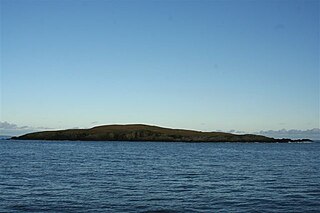
East Linga is one of the Shetland Islands. It lies between Whalsay, and Grif Skerry to the east.

Isbister Holm is a small islet in the Shetland islands of Scotland, situated roughly 2 kilometres (1.2 mi) east off the coast of Isbister, Whalsay. The highest point of the islet is about 65 feet (20 m) and it measures roughly 500 metres (1,600 ft) by 250 metres (820 ft). To the north are the islets of Mooa and Nista. On 12 November 1778 Jufron Ingester was shipwrecked, probably on the holm, the precise location not being certain. It was carrying some 260 tons of skins, tallow and coarse hose from Ireland to Copenhagen. One crew member died and the cargo was not salvaged.
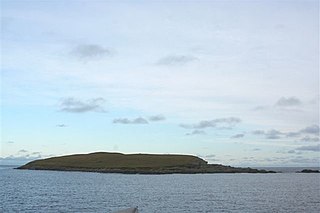
Nista is a small islet of the Shetland Islands of Scotland, situated roughly 2 kilometres (1.2 mi) east off the coast of Whalsay. It lies to the north of Mooa.

Mooa is a small islet of the Shetland Islands of Scotland, situated roughly 2 kilometres (1.2 mi) east off the coast of Whalsay. It lies to the north of Isbister Holm and south of Nista. The highest point of the islet is 63 feet (19 m).
Breiwick Burn is a burn (stream) in southeastern Whalsay, Shetland Islands, Scotland. The source of the stream is in the Ward of Clette, to the northeast of Clate and north of the quarry. It flows in an easterly direction, curving around to the south and entering the sea at the Ayre of Breiwick, northwest of Meo Ness, and northeast of Hellick.

Brough is a settlement in western Whalsay in the parish of Nesting in the Shetland islands of Scotland. It lies to the southwest of Challister, northeast of New Park, and north of Tripwell. To the north is Kirk Ness, and Whalsay Parish Church.
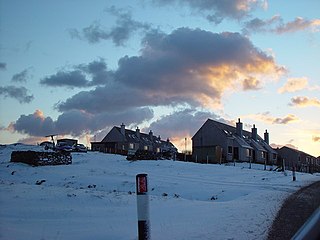
Tripwell is a hamlet in western Whalsay in the parish of Nesting in the Shetland islands of Scotland. It is located to the south of the village of Brough, northeast of Marrister. Scarfmoor Burn passes on the eastern side of the settlement, passing an old mill in Tripwell. Council houses were built in Tripwell in the late 1970, consisting of sheltered housing for senior citizens and 2 and 3 bedroom family houses.
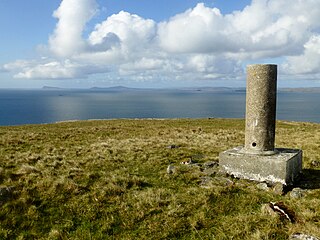
Clate is a hamlet and ward in southwestern Whalsay in the parish of Nesting in the Shetland Islands of Scotland.

Loch of Houll is a loch on Whalsay, one of the Shetland islands of Scotland. It is located to the southeast of Brough and on the eastern side of Setter Hill. An eastern tributary of the Scarfmoor Burn passes into the western side of the loch. It is described as a "large shallow loch with brown trout averaging 8-10 oz and some over 2 lbs." On the western side of the loch is Peerie Roonie House, a ruined stone house, which still has traces of the inner face of a drystone wall and drain. Archaeologists excavating at the site discovered stone tools dated to the Neolithic period and peat ash.
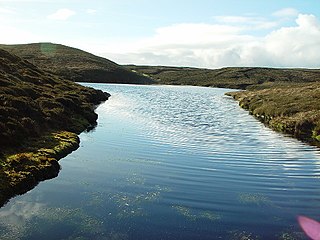
Little Water is a small loch of southern-central Whalsay, Shetland Islands, Scotland. It is located to the north of the Loch of Livister, south of the Loch of Houll, and west of the Loch of Stanefield.
Falsa Burn is a burn (stream) of southeastern Whalsay, Shetland Islands, Scotland. Roughly 600 metres (2,000 ft) in length, it ends near the sea to the south of Treawick, near Falsa Geo. Near the source, across the road from Nuckro Water is an unroofed building, which was probably used as a mill; it was shown on the 1st OS map of Orkney and Shetland in 1882.
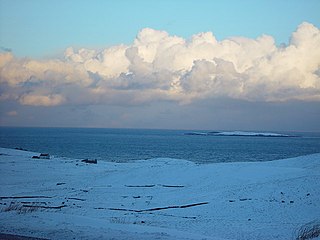
Treawick, also Traewick, is an uninhabited crofting village in eastern Whalsay in the parish of Nesting in the Shetland Islands of Scotland. It is located to the south of Isbister and northeast of Huxter. Falsa Burn flows into the sea just to the south. The name of the village is Old Norse for tree. In the 1930s, when the road from Symbister to Isbister was being planned, the villagers protested against it passing through the village so it passed to the west of the village. The old crofting houses here have long been abandoned. Offshore is Rumble.
The Inner Holm of Skaw is a small, uninhabited islet off the northern tip of the island of Whalsay, in the Shetland Islands of Scotland, north of the village of Skaw.
Whalsay Airstrip is located at the village of Skaw in the northern end of the island of Whalsay, Shetland, Scotland. It is the only airfield serving the island and is available for charter flights. The landing surface, which is 18 metres (59 ft) wide and 457 metres (1,499 ft) long, is constructed from rolled gravel.

The Skate of Marrister is a flat ledge that extends about 300 yards (270 m) from the western shore of Whalsay, in the Shetland islands of Scotland. It is slightly more than 1 mile (1.6 km) north-north-west from Symbister Ness off the village of Marrister, in Linga Sound. At low tide the ledge rises 5 feet (1.5 m) above the water. There is a risk that the strong tide in Whalsay Sound will carry a boat onto the Skate. There is a minor light on the Skate with a nominal range of four miles, flashing green every six seconds.

Setter Hill is a hill in western Whalsay, Shetland Islands, Scotland. It lies to the southeast of the village of Marrister and northeast of the main village on the island, Symbister. The source of Scarfmoor Burn is on the southeastern side of Setter Hill. On its eastern side is the Loch of Houll. There is an old quarry in the vicinity. Since the spring of 2001, the hill has been part of Shetland's Past Project, a project geared towards encouraging and training individuals to undertake archaeological surveys of their local landscapes in the Shetland Islands.

Whalsay Parish Church or Whalsay Kirk is a Church of Scotland parish church on the island of Whalsay, Shetland Islands, Scotland. It lies to the north of the village of Brough, on the southern part of a promontory known as Kirk Ness, connected to the mainland by a neck of land. It is the main burial ground for villagers of Whalsay. It is one of three churches in the Parish of Nesting, the others being at Nesting and Lunnesting. The church is a category B Listed Building.
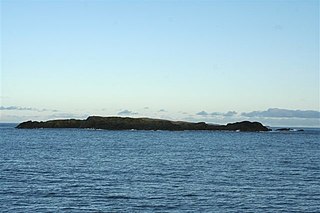
Rumble is a skerry in the Shetland islands of Scotland, situated roughly 4 kilometres (2.5 mi) east off the coast of Huxter, southeastern Whalsay. It lies 0.75 miles (1.21 km) to southwest of East Linga. The main island, also known as Rumble Holm, is 27 feet (8.2 m) high. Nearby and to the north are the Flaeshans of Rumble, a series of small islets and stacks and Burlastack of Rumble lies to the east. On the northern side of the main island is an inlet, known as the Voe of Rumble. Lobsters and prawns are said to shelter here. It is also mentioned that a ship named Griften of unknown nationality was shipwrecked either here or on the Holm of Sandwick in 1611.
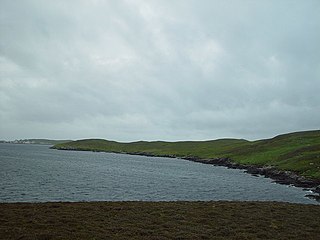
Linga Sound is the strait between the islands of Whalsay and West Linga in the Shetland islands of Scotland.
References
- ↑ "Site Record for Whalsay, Scarfmoor Burn". Royal Commission on the Ancient and Historical Monuments of Scotland . Retrieved 1 February 2013.
- ↑ "Scarfmoor Burn, HU 554 644 GB Grid". Ordnance Survey . Retrieved 1 February 2013.
Coordinates: 60°21′25″N0°59′56″W / 60.357°N 0.999°W